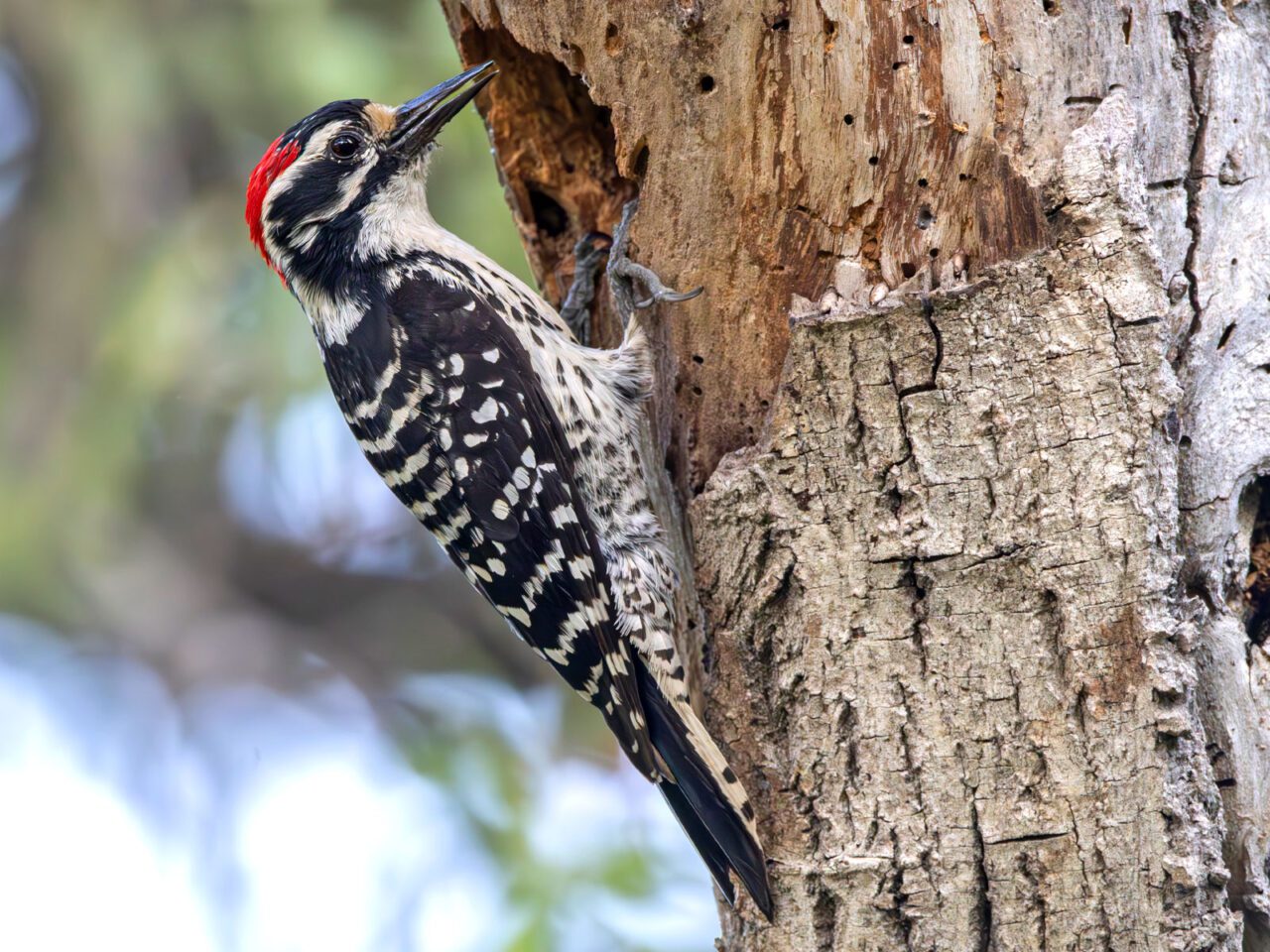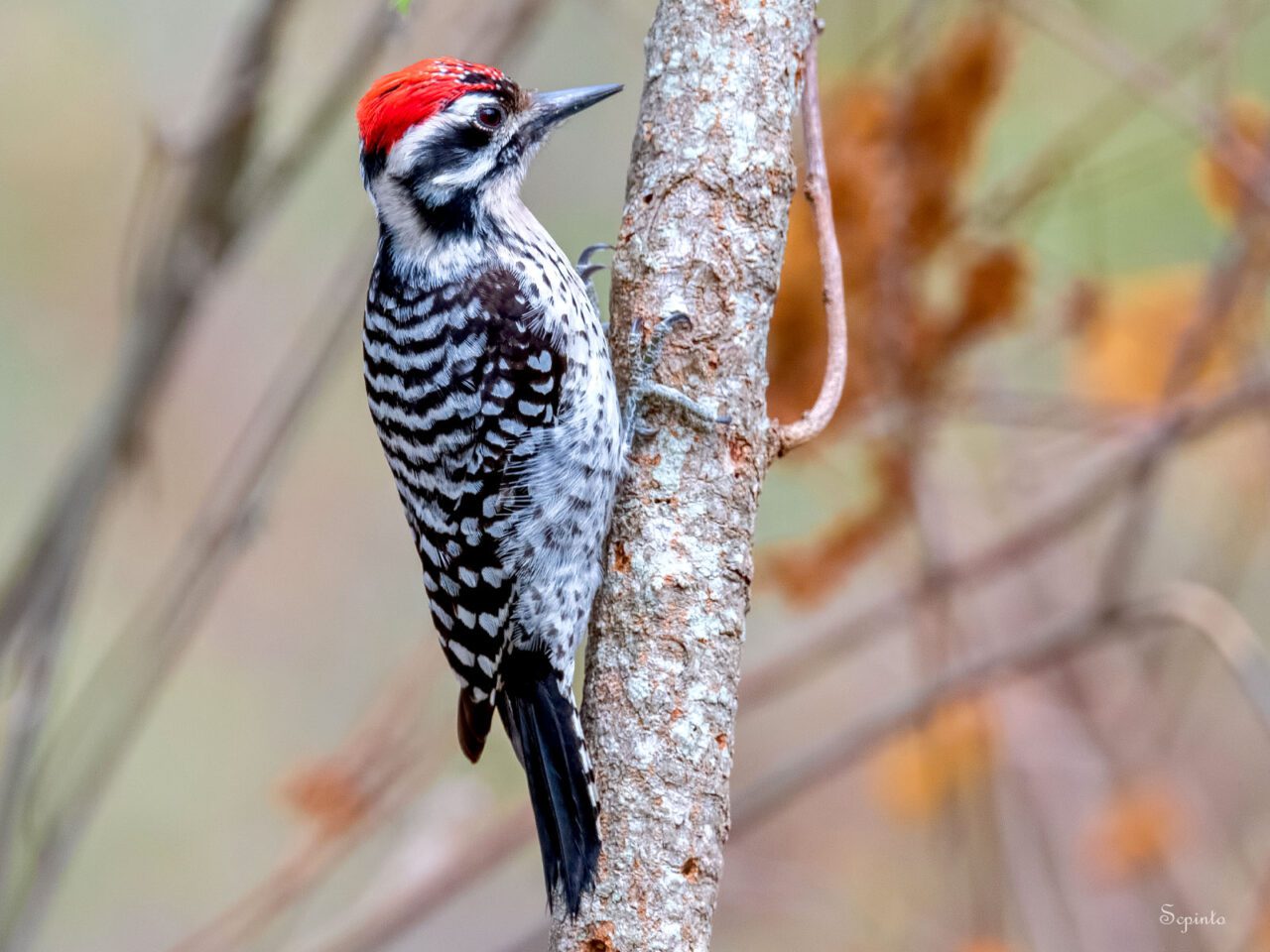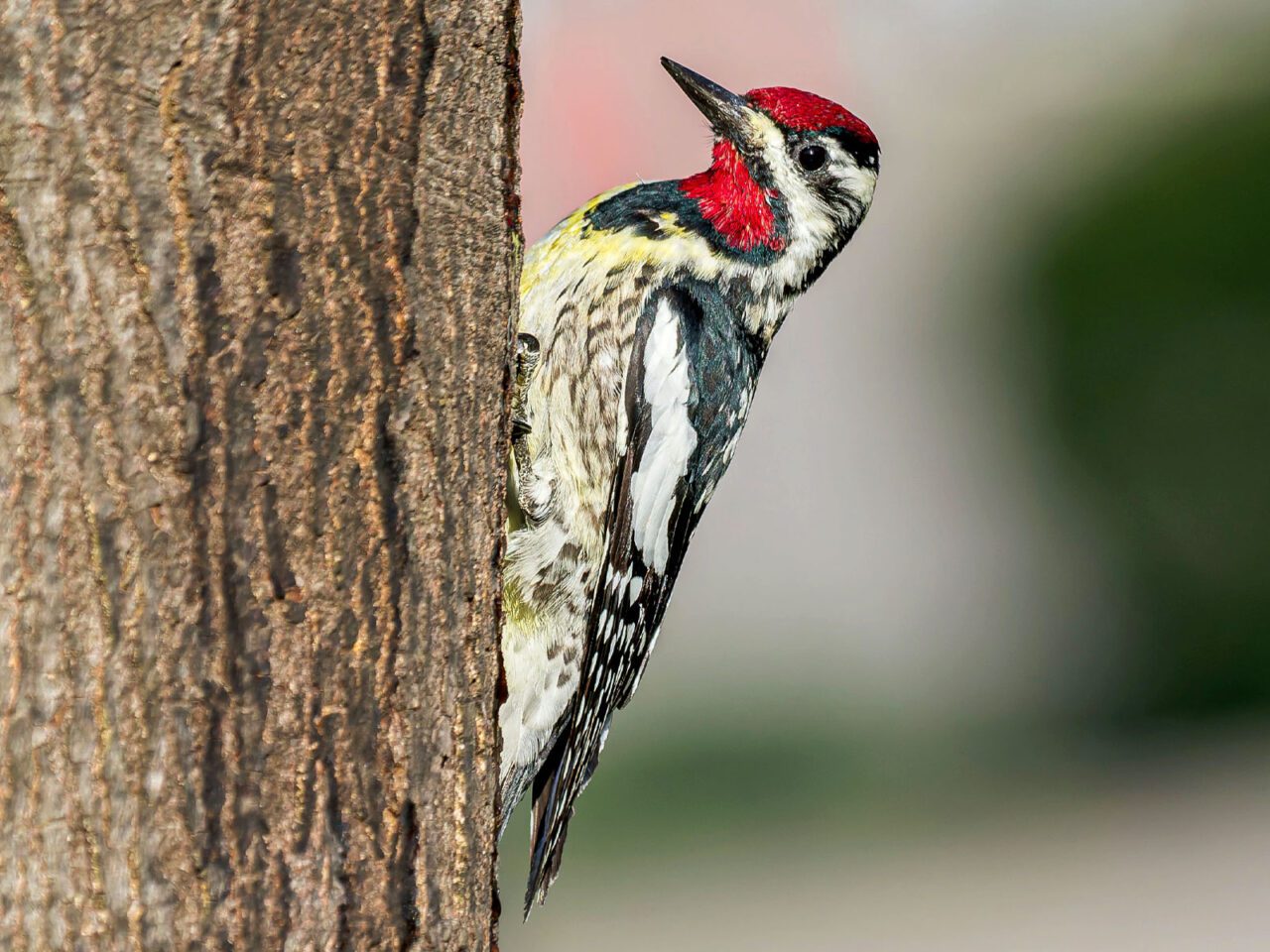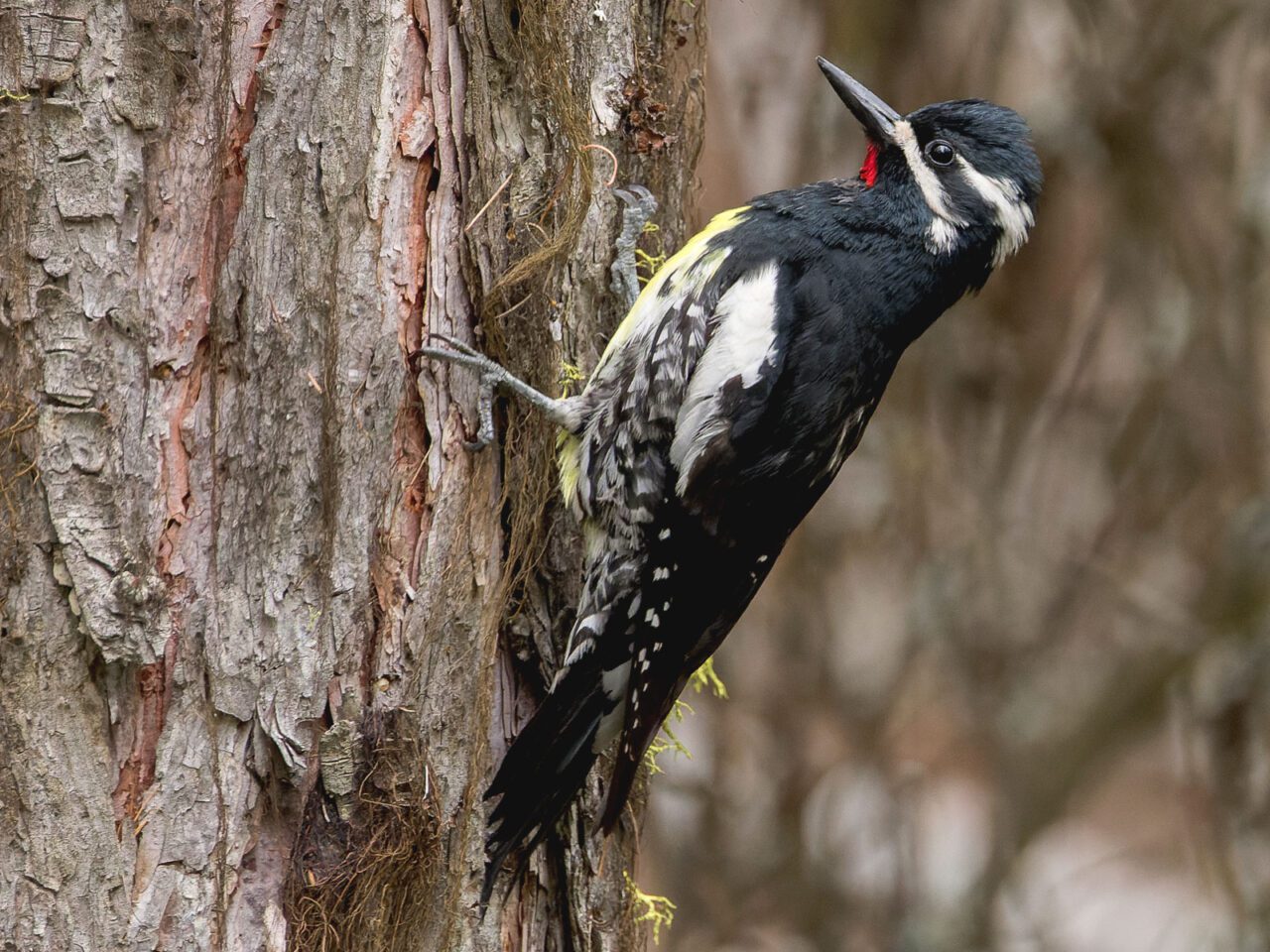Woodpecker drumming may not be as immediately distinctive as birdsong—but by carefully listening to speed, duration, and rhythm you can still tell many species apart. Here are some tips.
April 3, 2025
One of the first indications of springtime in North America is the rat-a-tat sound of woodpeckers drumming. Even on mild, sunny days in late winter you may hear them trying out their drumming. Compared with the melody and tone of birdsong, drumming isn’t quite as recognizable—but if you listen closely you can still tell some woodpeckers apart from others.
Woodpeckers can drum all year round, but there’s a noticeable uptick during the spring months—roughly March through June depending on your latitude. In woodpeckers, drumming serves the same function as song does for songbirds: it advertises a bird’s (or a pair’s) territory and helps attract mates. In most woodpecker species, both males and females drum.
How and Why Do Woodpeckers Drum?
Anytime you hear a fast, extended sequence of loud pecks—that’s drumming, and it’s all about communication. They’re not looking for food. In fact, during feeding woodpeckers peck slowly and make only faint noises as they choose when and where to take their next strike. (Listening out for these quiet, methodical pecking sounds can be helpful in tracking down a woodpecker as it’s busy feeding.)
This also explains why you often see woodpeckers drumming on metal surfaces like streetlights, gutters, and garbage can lids. They’re not confused about where their dinner is, they’re looking to make the loudest possible sound. If you watch a woodpecker drumming on a dead tree, you’ll often see it make minute adjustments in where it’s pecking. Sometimes a slight adjustment results in a much louder, farther-carrying sound.
3 Main Drumming Patterns
Rat-a-tat-tat: Steady, Evenly Spaced Drumming
The classic woodpecker drum is a steady delivery of fast strikes on a hard surface. Many woodpeckers drum this way, so it may seem difficult to identify them to species. But take heart—species that occur in the same regions of North America often sound different. It’s especially important to pay attention to speed and duration of the drumming.
Downy vs. Hairy Woodpeckers
Two of North America’s most widespread woodpeckers, Downy and Hairy, are commonly found together. Listen for the faster pace of the Hairy to tell them apart. It can be really helpful to look at spectrograms while listening to audio recordings, to help you pick out details of the sounds. Here’s more on how to read spectrograms.

The very similar Hairy Woodpecker drums faster (about 26 beats per second), and a bit longer (averaging 1 second) than Downy. It’s impossible to count the pecks as they happen. You can see the difference in these spectrograms—the lines indicating each strike are packed tighter together than in the Downy.
Nuttall’s vs. Ladder-backed Woodpeckers
In the southwestern U.S., Nuttall’s and Ladder-backed Woodpeckers can sometimes occur near each other. Like the Downy and Hairy, the difference in their drumming speed is noticeable.

Nuttall’s Woodpeckers have an intermediate delivery (about 20 beats per second), slightly faster than a Downy Woodpecker. Drums average about 1 second long, so there’s enough overlap with Downy Woodpecker that it is hard to tell these two species apart. But with practice the faster cadence of Hairy and Ladder-backed should be noticeable.

Ladder-backed Woodpeckers drum really fast—at about 30 beats per second, they’re even faster than a Hairy. It almost runs together into a single continuous sound. The speed of the delivery is noticeable in the spectrogram, with the lines indicating each peck packed very close together.
Northern Flicker
With Northern Flickers, each bout of drumming usually lasts for longer than a second—longer than many other species. In a spectrogram you can see how the cluster of lines indicating pecks is longer.
Northern Flickers drum at about 23 beats per second—faster than Downy, but only slightly slower than Hairy. Flickers often pause between drums and give their long, piping call, which also helps with recognition.
Stutterstep Rhythms: Sapsuckers
The complex rhythm of sapsucker drumming is instantly recognizable: an introductory roll followed by unevenly spaced beats consisting of very fast multiple taps. Sapsuckers are migratory, and when they return to breeding grounds their off-kilter drumming sound is for many birders a welcome sound of early springtime.

The closely related Yellow-bellied, Red-naped, and Red-breasted Sapsuckers (once considered a single species) have very similar drumming patterns. (Fortunately, their breeding ranges have very little overlap.) After the initial drumroll, they give double taps at irregular intervals that slowly space out. The double taps are so fast that on the spectrogram they almost look like a single strike.

Williamson’s Sapsuckers occur in mountains of western North America where they may overlap with Red-naped and Red-breasted Sapsuckers. Their drum is slightly different: after the initial drumroll, the ensuing beats consist of multiple (not doubled) hits. These beats get more widely spaced and softer as the drum goes on.
Fadeaways: Drumming that Trails Off at the End
The widespread Pileated Woodpecker has a distinctive drum befitting the bird’s size and power. These crow-sized woodpeckers often drum on large trees and produce a deep, powerful sound.
Pileated Woodpeckers drum slowly (about 15 beats per second), with slightly faster sections at the beginning and end that create a sense of the sound building up and then fading away.
Two uncommon species, Black-backed and American Three-toed Woodpeckers, are often sought after by birders. Their distinctive drumming can help you locate them once you’ve found the correct habitat.

American Three-toed Woodpeckers have a fairly long, slow drum—lasting 1.3 seconds or more with and with about 14 beats per second. The drumming speeds up noticeably at the end, creating a sense of the sound fading away. If you look closely at a spectrogram, you can see the space between the strikes shorten toward the end of the drum.

The slightly larger Black-backed Woodpecker drums faster and for longer than American Three-toed Woodpecker. Drums last for about 1.9 seconds—among the longest of the woodpeckers mentioned in this article—and they strike the tree at about 16 beats per second. The drum speeds up slightly at the end and the volume often trails off, giving a fadeaway effect.
Sources: Data on drumming speed and pattern come from the Birds of the World accounts for each species.

